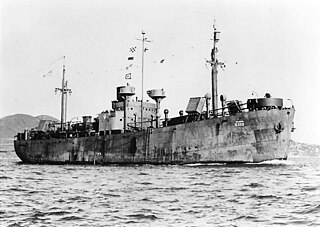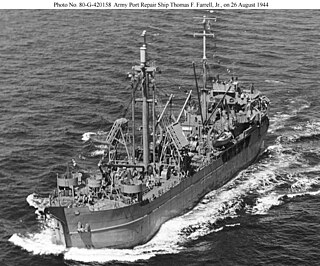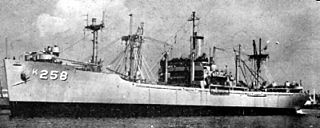
USS Betelgeuse (AK-260) was the last of the cargo ships in service in the United States Navy. On 10 April 1944, it was renamed the SS Colombia Victory after being launched as a Victory ship to carry cargo during World War II. She was transferred to the US Navy in 1951.

USS Oglala (ID-1255/CM-4/ARG-1) was a minelayer in the United States Navy. Commissioned as Massachusetts, she was renamed Shawmut a month later, and in 1928, was renamed after the Oglala, a sub-tribe of the Lakota, residing in the Black Hills of South Dakota.

USS Carina (AK-74) was a Crater-class cargo ship, and the only ship of the US Navy to have this name. She was named for the southern constellation Carina, with most of her sister ships being named for constellations or stars.

USS Appanoose (AK-226) was a Crater-class cargo ship in the United States Navy named for Appanoose County, Iowa.

USS Alchiba (AKA-6) was an Arcturus-class attack cargo ship of the United States Navy, named after Alchiba, a star in the constellation Corvus. She served as a commissioned ship for 4 years and 7 months.

USS Waccamaw (AO-109) was a Cimarron-class replenishment oiler in the United States Navy. She was named after Waccamaw River. The original capacity was 146,000 barrels (23,200 m3).

USS Pegasus was built in 1939 as SS Rita Maersk by Helsingør Jernskibs og Maskinbyggeri A/A, Helsingør, Denmark. Following the outbreak of World War II in Europe, she sailed to the United States where she operated under charter from the Maritime Commission as Rita Maersk and later as Larwin. After completing two cruises, she was laid up at Boston, Massachusetts, until 18 September 1941 when she was acquired by the United States Navy from the Maritime Commission. Renamed USS Pegasus on 15 October 1941, the cargo ship was converted for U.S. Navy use by Sullivan Drydock and Repair Corporation, New York City, and commissioned at New York on 3 December 1941.

USS Delta (AK-29/AR-9) was the lead ship of her class of repair ships in the United States Navy during World War II. She was originally built as the merchant ship SS Hawaiian Packer before her requisition by the U.S. Navy in 1941. Before conversion to a repair ships, Delta briefly served as a U.S. Navy cargo ship.

USS Uranus (AF-14) was a Uranus-class stores ship bareboat chartered to the U.S. Navy by the War Shipping Administration for use in World War II. The ship was one of the Danish vessels idled in U.S. ports seized by the United States after the occupation of Denmark by German forces. The ship was the Danish J. Lauritzen A/S line vessel Maria, ex Caravelle, ex Helga until chartered to the Navy and commissioned on 11 August 1941 under the name Uranus.

USS Hydra (AK-82), ex MV Eben H. Linnell, was an Enceladus-class cargo ship commissioned by the U.S. Navy for cargo service in World War II. Hydra was in naval service from 1 January through 19 November 1943 before she was transferred to the U.S. Army for conversion to the Engineer Port Repair ship Madison Jordan Manchester.

Mira (AK-84) was never commissioned and thus never bore the USS designation. The ship was transferred to become the U.S. Army Corps of Engineers Port Repair ship Robert M. Emery the day after acquisition by Navy.

Tucana (AK-88) was never commissioned and thus never bore the USS designation. She was transferred upon launching on 13 September 1944 to the U.S. Army as the U.S. Army Engineer Port Repair ship Arthur C. Ely.

Vela (AK-89) was never commissioned and thus never bore the USS designation. The ship was transferred to the Army to become the Engineer Port Repair Ship Joe C. Specker shortly after launching. She was one of two such repair ships transferred to Navy in 1952 and served as the civilian crewed, unarmed USNS Vela (T-AK-89).

USS Allegan (AK-225) was a Crater-class cargo ship commissioned by the U.S. Navy for service in World War II. She was responsible for delivering troops, goods and equipment to locations in the war zone.
USS Autauga (AK-160) was an Alamosa-class cargo ship commissioned by the US Navy for service in World War II. She was responsible for delivering troops, goods and equipment to locations in the war zone.

USS Adria (AF-30) was an Adria-class stores ship in service with the United States Navy from 1944 to 1954. She was scrapped in 1977.

USS Briareus was originally the cargo ship SS Hawaiian Planter laid down as a Maritime Commission type C3 Mod. at Newport News, Virginia, by the Newport News Shipbuilding & Dry Dock Company for the Matson Line and delivered 15 May 1941. After a brief pre-war commercial service and allocation to the Army for transport the ship was purchased by the United States Navy in February 1943 and converted to a repair ship.

USS Alcor, AK-259, was a Greenville Victory-class cargo ship in service with the United States Navy from 1952 to 1968. She was originally built in 1944 as SS Rockland Victory, a World War II era Victory ship. She was sold for scrap in 1970.

The second USS Altair (AK-257) was a United States Navy Greenville Victory-class cargo ship in commission from 1952 to 1953. She was converted into a Antares-class general stores issue ship (AKS-32) in 1953 and was in commission as such from 1953 to 1969, seeing extensive service during the Cold War. Prior to her U.S. Navy career, she had operated as the merchant ship SS Aberdeen Victory during the latter stages of World War II.

The second USS Antares (AK-258) was a United States Navy Greenville Victory-class cargo ship in commission from 1952 to 1959. She was converted into a general stores issue ship (AKS-33) in 1959-1960 and remained in commission as such until 1964. She saw extensive service during the Cold War. Prior to her U.S. Navy career, she had operated as the merchant ship SS Nampa Victory during the latter stages of World War II and in the years immediately after the war.
















